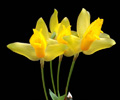|
|
|
|
|
| |
Established Seedlings of
Lycaste aromatica 'MC2043' -spontaneous |
|
| |
|
|
| |
| Number: |
TN3655 |
| Name: |
Lycaste aromatica 'MC2043' -spontaneous
|
| Type: |
spontaneous (What's that?) |
|
Seed Donor: |
Nina Rach
|
|
Click to Enlarge

Offspring 'MC6139' Blooming Plant |
Click to Enlarge

Offspring 'MC6139' Flower |
Click to Enlarge

Offspring 'MC6127' Flowers |
| Offspring photos are siblings of the plants you would receive. |
|
|
|
| |
Comments: Parent plant: Plant originally from Edo. Vera Cruz, Mexico
For additional origin/habitat information supplied courtesy of
Charles and Margaret Baker, see further below, near the bottom of this page.
|
Temperatures we attempt to use in the lab & greenhouse:
| For Species: |
|
Spring, Summer, Autumn: days average 79°F, nights 64°F; best fit is Intermediate 83-60°F
(Source:
Baker's Web OSC) |
| For Species: |
|
Winter: days average 76°F, nights 56°F; best fit is Cool-Intermediate 75-58°F
(Source:
Baker's Web OSC) |
|
About the name...
| Etymology of |
aromatica |
|
From latinized Arabic "aromaticus" fragrant, aromatic.
(Source:
Mayr & Schmucker 1998) |
| Etymology of |
Lycaste |
|
The beautiful sister of Helen of Troy, Lycaste.
(Source:
Pridgeon 1992) |
| Pronunciation of |
aromatica |
|
ah-row-MAH-ti-ka
(Source:
Hawkes 1978) |
| Pronunciation of |
Lycaste |
|
lie-CAST-ee
(Source:
Pridgeon 1992) |
|
If you would like to direct someone to this web page, please copy and paste this URL into your email:
http://troymeyers.com/d?123655
|
ESTABLISHED SEEDLINGS
of these are not currently available, but we have some maturing in the greenhouse and expect to offer them in the future.
There are 3 items with
1 plant per
item that will be considered for sale later.
Click here to see if we have flasks available.
|
|
|
| |
The origin/habitat information below is supplied courtesy of Charles and Margaret Baker
The following information is based on the name of the plant provided by the donor, and assumes that the name is correct. If the plant has been misidentified, then the following information may not be correct.
This text is copyrighted by the Bakers and may not be reproduced without permission.
ORIGIN/HABITAT: Mexico, Belize, Guatemala, Honduras, and Nicaragua. Plants
are usually found in the mountain watersheds that drain into the Gulf of
Mexico and the Caribbean. Williams (1951) reported that this species was
found in Mexico in the States of San Luis Potosí, Tamaulipas, Vera Cruz,
Puebla, Guerrero, and Colima and indicated that distribution extended into
Guatemala, Belize (British Honduras), and Honduras. Subsequent discoveries
added Nicaragua to the habitat, and Fowlie (1970) reported that the
species is fairly common in the mountains north of the Ocotal-Jalapa
Highway at about 4900 ft. (1500 m). Plants usually are found along rivers
in damp forests on trees and rocks at 2950–4900 ft. (900–1500 m). In
Mexico, plants are found as high as 6000 ft. (1830 m) near Tuxtla
Gutierrez and as low as 500 ft.(150 m) in the State of Vera Cruz.
More about this information and the Bakers...
|
|
|
| |
|
|
|